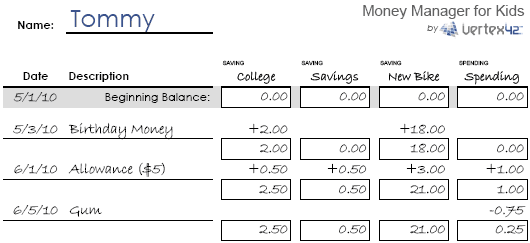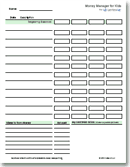Money Manager for Kids
This Page (contents):
Managing money is an important life skill that can be taught to children at a young age. Do you give your kids an allowance? Are they always misplacing their money? Are you helping them learn how to save? Do they understand how a bank works? All of these things can be done and taught quite simply using the "family bank" concept and a simple money management worksheet.
The Family Bank Approach
The basic idea is that parents act as the Family Bank, and each child keeps track of how much money they have in the bank using a worksheet like the ones below. Deposits and withdrawals are easy to handle, and when it comes time to give allowance, no cash needs to exchange hands.
Setting Up the Family Bank
1. Print a copy of the Money Manager for Kids worksheet for each child.
2. At the top of each column, enter a name for each savings or spending account. We use Charity, College (long-term savings), Savings (short-term savings), and Spending. Teach your children why it is important to keep their spending money separate from their savings, and the difference between long-term savings (like college) and short-term savings (like savings for a new bike).
3. Get a jar or container to use for the “Family Bank.” This is where you will keep some cash and change to handle the times when your kids need to have cash to pay for things at school, buy gum, etc. Keep the money in a safe/secret place.
4. Make the initial deposits. Have each child gather all of their money and then deposit the money into the family bank. Record the starting balances in their worksheet columns. It may be helpful to remind them that the money is still theirs – it's just going to be kept in a safe place so they don’t lose it, but when they need it, they can withdraw it from the family bank.
5. Tape the worksheets to the inside of a cupboard or pantry door. The kids can check how much money they have at any time, but perhaps make a rule that only a parent can write on the worksheet.
Origins
We got the idea to use the Family Bank approach from a family member who was already doing something similar for her kids. Previously, we were using the envelope approach, where you have a set of envelopes for each child's various spending money and savings. The problem was that we hardly ever had enough cash or small change on hand to handle breaking the amounts into the different envelopes. Also, we found that the kids were frequently losing the money, misplacing it, or simply giving it away (particularly the younger ones who could be easily manipulated by their older siblings). I created the above worksheets so that we could experiment with the Family Bank idea.
We used this method for all 5 of our kids. When they got old enough to have bank accounts, we transitioned them away from the Family Bank to a real bank. In addition, they graduated to the more advanced Money Tracker spreadsheet for tracking their finances. The final step is the Money Management Template.
Printable Money Management Worksheets
The two free downloads below are PDF files that you can print as-is. If you don't want to use Excel or Google Sheets, you can simply download these printable versions.
Money Manager for Kids
for Excel and OpenOfficeDownload
⤓ Excel (.xlsx)Other Versions
License: Private Use (not for distribution or resale)
Description
This simple money manager for kids is a great way to teach your children how to manage their money. Whether you give them allowance or they earn money from other opportunities or odd jobs, this template can help you teach them how to track their spending, save money, and split their money into different budget categories. You can also use this template with the Family bank Approach as mentioned above, and cash doesn't have to exchange hands!
The Excel workbook also contains a landscape version that allows you to include more categories. I created this for our older children who received an allowance and were required to budget and pay for their own clothes, school supplies, lunches, etc. This is something my parents had me do when I was growing up, and it taught me some good financial principles at an early age.
How to Use the Money Manager Worksheet
The image below shows an example of how to fill out this money management worksheet. It's basically just a simple register ... except that it lets you keep track of up to four separate balances at once. The example below shows a case where Tommy is putting a portion of his allowance and other money into (1) Savings for college, (2) General Savings, (3) Savings for a New Bike, and (4) Spending.

Example showing how to use the Money Manager worksheet
Balances: The current balance for each "account" or column is entered into the rectangular boxes. It should be pretty obvious how it works if you take a look at the example above.
Allowance: When you give an allowance, you don't have to give cash, you simply record the allowance as a deposit, divided up between savings and/or spending. Notice that in the example above, the $5 allowance was split into all 4 columns.
Deposits: If your child receives cash for work they've done or birthdays, they can hand you (the banker) the cash, and you record the deposit in the worksheet.
Withdrawals: If your child needs cash for some reason, you hand them the money from your wallet or purse (i.e. the bank) and record the withdrawal in the worksheet.
When you run out of space: After you've filled in a worksheet completely, you print out another blank copy and then record the current balances at the top of the new money manager worksheet.
Money-Making Opportunities for Kids
Most kids don't like to do chores, but learning how to work and save money is vital! It builds character, helps teach responsibility, and is one of the most important principles of personal finance. Although some work requires more maturity, there are jobs younger kids can do as well. Here are some ways your kids can make money.
Ideas for Ages 8 and Up
- Babysitting (12 and up)
- Odd Jobs (like washing cars)
- Pet Care (walking, washing, sitting)
- Mowing Lawns / Yard Work
- House Cleaning / Window Washing
- Lemonade Stand (might not make money, but it’s a classic summer activity! 😉
Ages 14 and Up
When teens are old enough, the best (most reliable) way to make money is to get a job. The minimum age that teens can get jobs is 14 years in most states. Although there may be some ways to supplement income or make a little cash on the side, having a job with consistent hours and income is a vital learning experience and can teach valuable lessons to teens about hard work, responsibility, and personal finance.
A few potential side-gig ideas for older kids to make extra money (if they have the necessary skills) are Tutoring, Photography, Music Lessons, plus most of the ideas mentioned in the previous section (with the exception of the Lemonade Stand).




